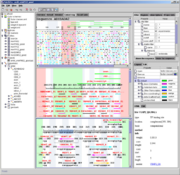Difference between revisions of "Transplorer"
m |
Tagir Valeev (Talk | contribs) |
||
| Line 7: | Line 7: | ||
A special algorithm was developed for matrix based search allowing to quickly process DNA sequences of any length including whole chromosome sequences. Transplorer can process DNA sequences in the most popular formats including [[EMBL format|EMBL]], [[GenBank format|GenBank]] and [[Fasta format|FASTA]]. | A special algorithm was developed for matrix based search allowing to quickly process DNA sequences of any length including whole chromosome sequences. Transplorer can process DNA sequences in the most popular formats including [[EMBL format|EMBL]], [[GenBank format|GenBank]] and [[Fasta format|FASTA]]. | ||
| − | Transplorer uses the biggest library of matrices derived from | + | Transplorer uses the biggest library of matrices derived from {{TRANSFAC}} and therefore provides a possibility to search for a great variety of different transcription factor binding sites. A search can be made using all matrices or their subset from the library. |
A specific subset of weight matrices along with their cut off similarity values is called "profile". The powerful Profile Editor allows a user to select matrices from TRANSFAC® Professional or the user's own matrix libraries. Applying different filters the user can select matrices for transcription factors with specified features: name, taxon, organism, DNA-binding domain and/or tissue specificity. Profile editor also allows the user to specify a cut off similarity value for each matrix providing on fly estimation of a false positive for the given cut off value. | A specific subset of weight matrices along with their cut off similarity values is called "profile". The powerful Profile Editor allows a user to select matrices from TRANSFAC® Professional or the user's own matrix libraries. Applying different filters the user can select matrices for transcription factors with specified features: name, taxon, organism, DNA-binding domain and/or tissue specificity. Profile editor also allows the user to specify a cut off similarity value for each matrix providing on fly estimation of a false positive for the given cut off value. | ||
| Line 21: | Line 21: | ||
Color schemes are a distinctive feature of Transplorer site visualization. Color schemes define the site view depending on its features: similarity with a weight matrix, site type or peculiarities of transcription factor binding with the site. This greatly improves users' comprehension of complicated sequence maps with many sites. | Color schemes are a distinctive feature of Transplorer site visualization. Color schemes define the site view depending on its features: similarity with a weight matrix, site type or peculiarities of transcription factor binding with the site. This greatly improves users' comprehension of complicated sequence maps with many sites. | ||
| − | Transplorer is tightly integrated with | + | Transplorer is tightly integrated with {{TRANSFAC}} via its Web interface. |
==External links== | ==External links== | ||
Revision as of 16:46, 3 June 2013
Transplorer is a software package for recognition and visualization of transcription factor binding sites in DNA sequences. It was developed by DevelopmentOnTheEdge.com for BIOBASE GmbH for the prediction of regulatory regions in gene sequences.
While Transplorer is a pure Java application it can be executed on various platforms.
A special algorithm was developed for matrix based search allowing to quickly process DNA sequences of any length including whole chromosome sequences. Transplorer can process DNA sequences in the most popular formats including EMBL, GenBank and FASTA.
Transplorer uses the biggest library of matrices derived from TRANSFAC® Professional database and therefore provides a possibility to search for a great variety of different transcription factor binding sites. A search can be made using all matrices or their subset from the library.
A specific subset of weight matrices along with their cut off similarity values is called "profile". The powerful Profile Editor allows a user to select matrices from TRANSFAC® Professional or the user's own matrix libraries. Applying different filters the user can select matrices for transcription factors with specified features: name, taxon, organism, DNA-binding domain and/or tissue specificity. Profile editor also allows the user to specify a cut off similarity value for each matrix providing on fly estimation of a false positive for the given cut off value.
Search results along with search parameters are called "project". Powerful Project Wizard guides a user through the analysis steps.
The search results are stored in the database. The results can be presented in tabular form, where rows are sites and columns are site features. The user can insert or delete binding sites, comment or change site descriptions. The database also stores experimental, structural and regulatory gene regions and extract an EMBL or GeneBank Feature Table.
Transplorer provides a very powerful graphical presentation of the results in the form of a gene sequence map. There are three map modes: the overview mode allows the user to visualize long sequences as a whole; the default and detailed modes are used to provide a thorough visualization of results. Transplorer allows a user to work in several modes simultaneously: in the overview mode the user can select the sequence region of interest and investigate this region more thoroughly in default and/or detailed mode.
A powerful set of filters allows the researcher to visualize binding sites for transcription factors with specified features: name, taxon, organism, DNA-binding domain and/or tissue specificity.
Color schemes are a distinctive feature of Transplorer site visualization. Color schemes define the site view depending on its features: similarity with a weight matrix, site type or peculiarities of transcription factor binding with the site. This greatly improves users' comprehension of complicated sequence maps with many sites.
Transplorer is tightly integrated with TRANSFAC® Professional database via its Web interface.
